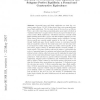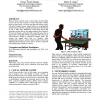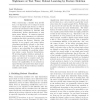65 search results - page 4 / 13 » Classifying input for active games |
CORR
2007
Springer
13 years 7 months ago
2007
Springer
Abstract. Sequential game and Nash equilibrium are basic key concepts in game theory. In 1953, Kuhn showed that every sequential game has a Nash equilibrium. The two main steps of ...
CHI
2010
ACM
14 years 15 days ago
2010
ACM
Unlike machines, we humans are prone to boredom when we perform routine activities for long periods of time. Workers’ mental engagement in boring tasks diminishes, which eventua...
CHI
2008
ACM
14 years 7 months ago
2008
ACM
The recent development of controllers designed around natural body movements has altered the nature of gaming and contributed towards it being marketed as a more social activity. ...
ACMACE
2007
ACM
13 years 11 months ago
2007
ACM
Physical leisure activities such as table tennis provide healthy exercise and can offer a means to connect with others socially; however, players have to be in the same physical l...
ICML
2006
IEEE
14 years 8 months ago
2006
IEEE
When constructing a classifier from labeled data, it is important not to assign too much weight to any single input feature, in order to increase the robustness of the classifier....



